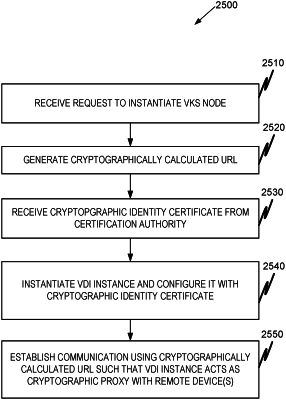| CPC H04L 63/0281 (2013.01) [G06F 9/452 (2018.02); H04L 9/0863 (2013.01); H04L 9/3268 (2013.01); H04L 63/0428 (2013.01)] | 20 Claims |

|
1. A method for establishing secure communications comprising:
receiving, from a client computing device, a request to instantiate a virtual key store (VKS) node uniquely associated with a user of the client computing device;
causing the VKS node to be instantiated;
generating, in response to the request and after instantiation, a cryptographically calculated uniform resource locator (URL) based on an identification of the user and a key;
receiving, by the VKS node from a certification authority server, a cryptographic identity certificate;
instantiating a virtual desktop infrastructure (VDI) instance and configuring the VDI instance with the cryptographic identity certificate; and
establishing, using the generated cryptographically calculated URL, communications between the client computing device and the VDI instance such that the VDI instance acts as a cryptographic proxy with at least one remote computing device.
|